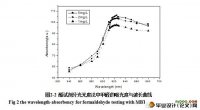室内温度对空气质量的影响
来源:56doc.com 资料编号:5D9459 资料等级:★★★★★ %E8%B5%84%E6%96%99%E7%BC%96%E5%8F%B7%EF%BC%9A5D9459
资料以网页介绍的为准,下载后不会有水印.资料仅供学习参考之用. 密 保 惠 帮助
资料介绍
室内温度对空气质量的影响(含任务书,开题报告,外文翻译,毕业论文12000字,答辩PPT)
摘 要
装修污染已成为人们最关注的室内环境污染问题,鉴于室内环境与人体健康的密切联系,我们应对室内空气质量(indoor air quality, IAQ)予以重视。甲醛作为重要的污染项目之一,其浓度是衡量IAQ的重要指标,本实验旨在研究温度对室内甲醛浓度——时间规律的影响。
在不同温度(14℃、18℃、23℃)条件下,利用小型环境测试舱动态平衡法测定舱内甲醛散发率随时间的变化。采用酚试剂比色法测定甲醛即时浓度,换算得到甲醛即时散发率,绘制散发率——时间曲线,得到甲醛散发率随时间的衰减模型(R=f(t)),并研究温度因子对散发率衰减模型的影响。在甲醛散发率衰减模型的基础上推导甲醛浓度衰减模型(C=f(t))。
实验结果表明:1)甲醛散发率一般会随时间的推移而降低;2)室内甲醛浓度模型C=f(t)可以在散发率模型R=f(t)的基础上得出。3)在保持其它实验条件不变,随着室内温度T的上升,污染源中甲醛的初始散发率R0增大,衰减系数k随之增大;多个污染源存在时,甲醛初始浓度由散发率较高污染源决定,浓度衰减模型则散发率衰减速度较慢污染源决定。
关键词:室内空气质量(IAQ);甲醛;温度;散发率模型
The influence of temperature on the indoor air quality
Abstract
In recent years, decoration has become one of the most common causes for indoor pollution. The indoor environment influences human healthiness greatly, so we must pay attention to the indoor air quality (IAQ). Formaldehyde is an important item in all the indoor pollutants, and it is an evaluation index for the indoor air quality. This thesis is to study the temperature influence on the regular pattern of the formaldehyde concentration VS time.
The small environmental test chamber dynamic balance method is used to measure the regular pattern of the formaldehyde emission rate VS time under different temperatures (14℃, 18℃, 23℃). Formaldehyde immediate concentration is detected by phenol reagent spectrophotometry firstly, the immediate formaldehyde emission rate in the chamber calculated from the concentration secondly,the R-t curve is made and the formaldehyde emission rate VS time model (R=f(t)) is derived, then the temperature factor influence can be got. We can also obtain formaldehyde concentration VS time model (C=f(t)) from the formaldehyde emission rate model.
The experimental results show: 1) the formaldehyde emissions rate R will decrease with time. 2) the concentration model of formaldehyde C=f(t) can be derived from the emission model R=f(t); 3)the initial formaldehyde emission rate (R0) and decreasing coefficient are increasing with the temperature T rising. The initial formaldehyde concentration is decided by the polluting source with the higher emission rate, while the concentration attenuate model is decided by the polluting source with the lower emission rate.
Key words: indoor air quality (IAQ); formaldehyde; temperature; emission rate model

目 录
摘要 I
Abstract II
1引言 1
2 实验方法 2
2.1实验原理 2
2.2 实验原料和设备 4
2.3 实验条件 5
2.4 环境测试舱甲醛浓度测定 7
2.5 污染源散发率的测定 7
3 结果与讨论 9
3.1 板材中甲醛散发率模型 9
3.1.1 散发率模型测定 9
3.1.2 温度对散发率模型的影响 12
3.2 室内甲醛浓度预测模型 17
3.2.1 甲醛浓度预测模型 17
3.2.2 预测模型的分析与求解 19
3.2.3 甲醛浓度预测模型的验证 19
4 结论 20
5 参考文献 21
致谢 24
|



